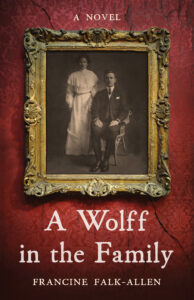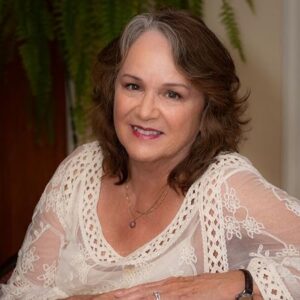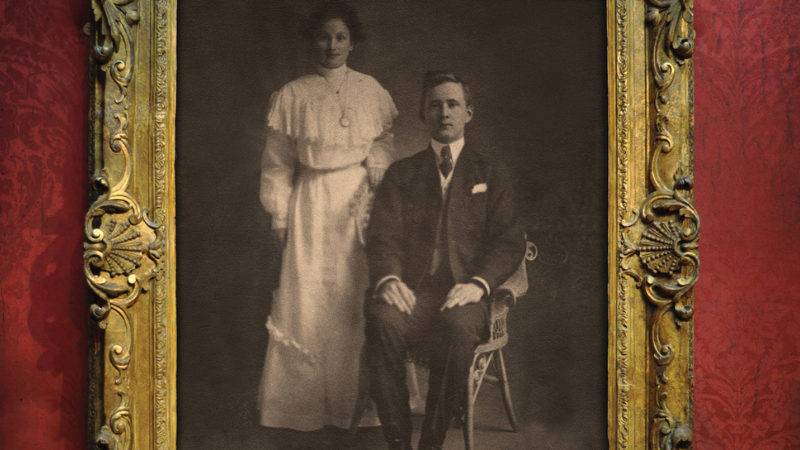 Award-winning author Francine Falk-Allen’s two acclaimed memoirs have been featured by Buzzfeed and PopSugar, and have received a Kirkus star. A fan of genealogy research, Francine enjoyed uncovering her family’s history, and traced both her maternal and paternal ancestors back to the 1600s. She never imagined that one day she’d discover a jaw-dropping family secret.
Award-winning author Francine Falk-Allen’s two acclaimed memoirs have been featured by Buzzfeed and PopSugar, and have received a Kirkus star. A fan of genealogy research, Francine enjoyed uncovering her family’s history, and traced both her maternal and paternal ancestors back to the 1600s. She never imagined that one day she’d discover a jaw-dropping family secret.
Based on a true story, Falk-Allen’s “A Wolff in the Family” (She Writes Press, Oct. 1, 2024) is a riveting saga of prejudice, passion, and revenge, perfect for fans of Kristin Hannah’s “The Four Winds.” What mysterious scandals led a father to abandon his five youngest children—and the elder siblings to keep their shame a secret for eighty years?
More about the book: Railroad engineer Frank Wolff and Kansas farmgirl Naomi Sims were happily married in 1908. Naomi was excited to take up her role as wife and mother and make a life with Frank in thriving Ogden, Utah. Despite Frank’s almost-constant absence due to his job riding the rails, their romantic relationship resulted in fourteen children. The young mother’s life was consumed with caring for her brood, who became helpers as soon as they could fold a diaper. Affection and conflict endured side by side in the humble house, but the marriage ultimately faced insurmountable challenges—just before the Depression took hold of the nation.
“A Wolff in the Family”
Francine Falk-Allen | October 1, 2024 | She Writes Press | Historical Fiction
Paperback | ISBN: 978-1-64742-802-0 | $18.99
Ebook | ISBN: 978-1-64742-803-7 | $12.99
Praise for the Author…
“A Wolff in The Family is an absolute page-turner! Immediately immersive, readers will be drawn into the hardships and small joys of the Wolff family as they attempt to make a living in rural Utah—Frank as a philandering “railroad man” and Naomi as a suffering housewife and mother of ten children with little emotional support from Frank. Falk-Allen paints a realistic picture of the West during the early part of the twentieth century with her vivid prose and realistic characters. An intriguing story about social norms, gender roles, and, ultimately, love. This is a fast, absorbing story that will keep you up long into the night. Couldn’t put it down!” —Michelle Cox, author of The Fallen Woman’s Daughter
“‘A Wolff in The Family’ is an absolute page-turner! Immediately immersive, readers will be drawn into the hardships and small joys of the Wolff family as they attempt to make a living in rural Utah—Frank as a philandering “railroad man” and Naomi as a suffering housewife and mother of ten children with little emotional support from Frank. Falk-Allen paints a realistic picture of the West during the early part of the twentieth century with her vivid prose and realistic characters. An intriguing story about social norms, gender roles, and, ultimately, love. This is a fast, absorbing story that will keep you up long into the night. Couldn’t put it down!”
—Michelle Cox, author of “The Fallen Woman’s Daughter”
“Heartbreaking at its core, Francine Falk-Allen’s ‘A Wolff in the Family’ takes the bones of a long-hidden family secret and fleshes it out to include a large cast of characters who come alive on the page. From abject poverty and a life saddled with a dozen children she’s raising alone, Naomi Wolff is drowning: physically, emotionally, and spiritually. Seeking comfort in a forbidden friendship, she is stripped of her children by her abusive and vindictive husband. Kudos to Falk-Allen for taking this project on, making it both compelling and relatable, and shedding light into dark corners of family history. A bold and important read.”
—Ashley E. Sweeney, author of “Eliza Waite”
“Francine Falk-Allen has skillfully accomplished this family-story-to-novel rebirth in ‘A Wolff in the Family.’ Set a century ago in Utah and surrounding states, the hard-scrabble life, children and marriages of Naomi Wolff vividly recall a world of societal rules, privation, race and class restrictions, and the human spirit that can prevail over all of them with love and devotion. Another great read from this author!”
—Barbara Stark-Nemon, author of “Even in Darkness” and “Hard Cider”
“An empathetic lesson in resilience and forgiveness, ‘A Wolff in the Family’ takes an unflinching look at complex familial ties, gender roles, and the hardships of women in the early 20th century through one family’s story across the United States. With the kind of drama that builds, this captivating book is a multifaceted tale with flawed and human characters and the complicated decisions that make a life.”
—Joanne Howard, author of “Sleeping in the Sun”
About the Author…
 FRANCINE FALK-ALLEN: was born in Los Angeles and has lived nearly all of her life in northern California. She had polio in 1951, and has lived her life as a disabled person making an effort to be a “normie.”
FRANCINE FALK-ALLEN: was born in Los Angeles and has lived nearly all of her life in northern California. She had polio in 1951, and has lived her life as a disabled person making an effort to be a “normie.”
Falk-Allen was originally an art major and later completed her BA in Managerial Accounting, running her own business for over thirty years. She has always sought creative outlets, such as painting, singing, and writing. She began doing extensive family genealogy research in 1999, and has traced both her maternal and paternal ancestors back to the 1600s.
Her first book, “Not a Poster Child: Living Well with a Disability,” won gold and silver awards and was on several best books lists in 2018 and 2019, including Kirkus Reviews’ Best Books of 2018, PopSugar and BuzzFeed, and was nominated to 25 Women Making a Difference in 2019 by Conversations Magazine.
Her second book, “No Spring Chicken: Stories and Advice from a Wild Handicapper,” received a Kirkus star, given to “books of exceptional merit” by Kirkus Reviews, and was named to Kirkus Reviews’ Best Books of August 2021. “No Spring Chicken” was also a finalist in Foreword Reviews’ Indie Awards in 2021.
Her third book, “A Wolff in the Family” is a riveting early twentieth century saga set in the western United States and based on scandalous family history.
Francine spends a significant amount of time managing the effects of post-polio. She facilitates a polio survivors’ group as well as a writing group, and volunteers on her town’s Americans with Disabilities Act Accessibility Committee. She loves the outdoors, swimming, gardening, movies, well-written literature, being with friends and sharing British tea and a little champagne now and then. She resides in San Rafael, California, with her husband. Learn more at: https://francinefalk-allen.com
In an interview, Francine Falk-Allen can discuss:
- How a long-buried family secret came to light and inspired the writing of “A Wolff in the Family”
- How she blended fact with fiction to create an accurate and compelling rendition of her family history
- How she made the transition from nonfiction to fiction writing
- Why it’s important to portray how gender inequality, racism, and shame affected her ancestors
- What the research process was like for “A Wolff in the Family,” especially considering how historical records of women’s lives and accomplishments are often hard to come by
- Her journey with genealogy and her advice for others looking to uncover lost family histories
An Interview with
Francine Falk-Allen
1. What inspired you to write “A Wolff in the Family”?
At a memorial service for one of my mother’s myriad brothers and sisters, an aunt mentioned offhandedly, “When we were in the orphanage…” and I was taken aback. My mother, long dead and the eldest child, had never mentioned this. I said, “Aunt Dorothy, what orphanage? What are you talking about?” She then gave me two or three more surprising comments which led me to inquire with other family members, and meld it with what my mother had related… and I thought it was just too juicy a story to pass up. I’m the author in the family, so I felt that it fell to me.
2. How much of the book is true-to-life, and how much is fiction?
The main events of the story, including how the youngest children ended up in an orphanage and some of the events that led up to that, are factual, and most of the resulting repercussions are true as well. I had to surmise how some of these things came to pass, and using census records and family birth, marriage and death records, I pieced together where people would have been, which led me to guess how some of the characters could have met in a particular way or place; so some of that is made up but based on possibility. I also included family vignettes which really happened. I made up nearly all of the conversations, of course, which took place from 1918 through the early 1950’s, but I set everything in places that really existed. All of the characters were real people, some of whom I knew, with most of the names changed.
3. What was the research process like for you?
As a genealogy buff, I loved doing the research. Not only was looking up the census material fun for me, but researching newspapers for bits on a divorce, and how much things cost in those days in the areas where the story takes place. For instance, I learned that my mother’s family would likely not have afforded a vacuum yet but probably used a carpet sweeper. Details like this add realism to the story. My mother loved to sing, and I assumed her mother probably did as well, so I looked up which songs were popular at different points in the story, along with which films and celebrities. I felt immersed in the era from 1918 through the 40’s, especially.
4. What advice would you give to readers who are interested in doing research on their own family histories?
Start with what you know, and ask the people who are the oldest in your life what they remember or know to be factual, such as the dates of your ancestors’ births and deaths, plus any stories they can tell. There are bound to be some myths which are not true (there were in my father’s family as well). Then you can do internet research such as is available in Family Search or Ancestry, but you have to be careful, because many people will insert things they think are true without having seen an actual birth, marriage, christening, baptism, military or death record. I originally went in person to the source, the National Archives, twenty-five years ago, and some other locations, and looked for copies of original documents, as did some of my cousins, especially the Allen cousins, not as much the Mormons on my mother’s side; they have been less careful even though they have a reputation for interest in genealogy. Notation should be made for estimates and unverified stories, but many amateur family sleuths do not do due diligence. In the process you may unearth written newspaper articles or other stories, such as whether a relative’s death record listed slaves as assets, or whether they owned a particular piece of property, which can lead you to their location and more possible stories! Once you get the bug, allow lots of time, because it’s a fascinating tunnel to pursue.
Download press kit and photos

A former award-winning journalist with national exposure, Marissa now oversees the day-to-day operation of the Books Forward author branding and book marketing firm, along with our indie publishing support sister company Books Fluent.
Born and bred in Louisiana, currently living in New Orleans, she has lived and developed a strong base for our company and authors in Chicago and Nashville. Her journalism work has appeared in USA Today, National Geographic and other major publications. She is now interviewed by media on best practices for book marketing.


